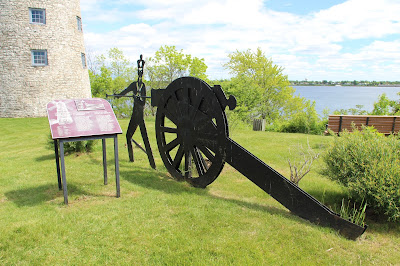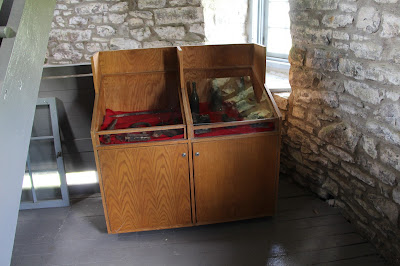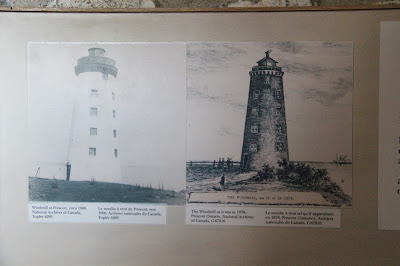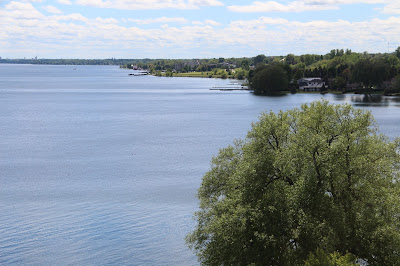 |
| This picture and the next two show Ogdensburg, New York, in the United States of America, on the other side of the St. Laurence River. |
WELCOME TO THE SITE OF THE BATTLE OF THE WINDMILL
You are standing on a battlefield where men fought and died. This battle took place in November 1838, during the Canadian rebellions. One side fought to "liberate" Canada from British rule. The other side rallied to protect their homes or the established political order.
The lighthouse in front of you is a converted windmill around which the battle was fought.
Fort Wellington, a few kilometres to the west in Prescott, was a gathering point for the British troops at the time of the battle.
The fort still stands and is now open to the public.
The Battle of the Windmill and the Fort Wellington sites are both preserved and operated by the Canadian Parks Service of Environment Canada.
BIENVENUE AU SITE DE LA BATAILLE DU MOULIN À VENT
Vous êtes sur un ancien champ de bataille. Des hommes sont morts ici en novembre 1838, durant la rébellion des Patriotes. Les uns voulaient libérer le Canada. Les autres sont accourus pour protéger leurs foyers ou le pouvoir britannique.
Le phare devant vous est un ancien moulin à vent qui s'est trouvé au cœur de la bataille.
Le Fort Wellington, qui se trouve à quelques kilomètres à l'ouest, à Prescott, servait à cette époque de point de ralliement à l'armée britannique.
Il a été restauré et il est aujourd'hui overt au public.
Le site de la bataille du Moulin à vent et le Fort Wellington sont tous deux exploités par le Service canadien des parcs du ministère de l'Environnement.
THE BATTLE OF THE WINDMILL
LA BATAILLE DU MOULIN À VENT
After the 1837 Rebellions many rebels fled to the United States where a few joined American sympathizers in a new attempt to overthrow British rule in Canada. On 12 November 1838 they landed 190 men here and seized this windmill and nearby buildings. The local people remained loyal, reporting to their militia units; in a few days 2,000 militia and regulars, supported by naval vessels, beseiged the mill. Although British guns did little damage to the mill, the insurgents, seeing no escape, surrendered on the 16th. Eleven were later executed and 60 exiled to Australia.
Après la Rébellion de 1837, de nombreux rebelles se réfugièrent aux États Unis où, aidés des Américains, ils organisèremt une nouvelle tentative de renverser le règne britannique au Canada. Le 12 novembre 1838, 190 hommes s'emparèrent du moulen à vent et des bâtiments voisins. Les gens du pays se présentèrent à la milice locale; en quelques jours, 2,000 miliciens et réguliers, appuyés par des navires, attaquèrent le moulin. Les assaillant firent peu de dégâts dans la bataille acharnée, mais les insurgés, sans espoir de s'échapper, se rendirent le 16. On en pendit 11 et déporta 60 an Australie.
Historic Sites and Monuments Board of Canada.
Commission des lieux et monuments historiques du Canada.
Government of Canada · Gouvernement du Canada
This plaque commemorates the designation of Windmill Point lighthouse under the Heritage Lighthouse Protection Act.
HERITAGE LIGHTHOUSE
Cette plaque commémore la désignation du phare de Windmill Point en vertu de la Loi sur la protection des phares patrimoniaux.
PHARE PATRIMONIAL
Government of Canada
Gouvernement du Canada
LIBERTY
WHAT CAUSED THE 1838 BLOODSHED?
During the 1820's and 1830's, Canada was a British colony governed by a small ruling elite.
A section of the population of Upper and Lower Canada demanded political reforms. These reformers wanted a broadly based democratic form of government.
The were opposed by those who feared radical change and the loss of the British connection.
The clash between reformers and the ruling elite led to open rebellion by many of the reformers in 1837.
Although the rebels were soundly defeated, many of their goals were gradually achieved.
POUQUOI LE SANG A-T-IL COULÉ EN 1838?
Dans les années 1830, le Canada était une colonie britannique contrôlée par une élite politique et militaire.
Une partie de la population du Haut et du Bas-Canada revendiquait des réformes. Elle réclamait des institutions pleinement démocratiques.
Contre elle se dressait le groupe au pouvoir, qui rejetait tout changement et voulait maintenir la tutelle coloniale.
C'était l'impasse. En 1837, des milliers de réformistes entrèrent en rébellion ouverte.
Ils subirent une cinglante défaite. Malgré cela, leurs objectifs démocratiques sont aujourd'hui des acquis indiscutales de notre société.
THE BATTLE OF THE WINDMILL
LA BATAILLE DU MOULIN À VENT
PRELUDE TO THE BATTLE
In 1837 the British army and loyal militia crushed the first armed revolt in Upper and Lower Canada. Many rebels fled to the United States. The exiles joined with American sympathisers to form a secret paramilitary organization, the Hunter's Lodge.
In November 1838, a group of Hunters planned an invasion of Canada at Prescott. It was expected that the local population would join in "liberating" the country from British control.
PRÉLUDE À LA BATAILLE
En 1837, l'armée britanique étouffe une première révolte armée dans le Haut et le Bas-Canada. Beaucoup de Patriotes s'exilent aux États-Unis. Avec l'aide de sympathisants américains, ils mettent sur pied une organisation paramilitaire secrète, les Frères Chasseurs.
En novembre 1838, un groupe de Chasseurs planifie une invasion du Canada à Prescott. Il s'attend à ce que la population locale se joigne à lui pour supprimer la tutelle britanique.
THE BATTLE UNFOLDS
1. Early on the morning of November 12, 1838, 190 Hunters landed at Windmill Point. Most were Americans. Contrary to their expectations, the local population did not rally to their side.
2. By November 13, over 2,000 local militiamen and British soldiers surrounded the rebel position. After a bitter and bloody skirmish, the government forces drove the rebels into the windmill and surrounding stone buildings. But they could not attack these buildings without large cannons.
3. November 14 and 15 were uneventful. The Hunters were counting on help from the United States that never came, while the British awaited artillery reinforcements.
4. November 16 was decisive. British gunboats patrolled the river while their field guns arrived by land. In the afternoon, they bombarded the rebels for two hours.
5. The Hunters were low on ammunition, food and water. There were no medical supplies to ease the pain of their wounded. By nightfall, they ran out of both resources and hope, and surrendered unconditionally.
UNE LUTTE INÉGALE
1. Le 12 novembre 1838, au petit matin, 190 Frères Chasseurs débarquent à la pointe du Moulin. La plupart sont des Américains. Contrairement à leurs attentes, la population reste loyale.
2. Dès le 13 novembre, plus de 2000 miliciens et soldats britanniques encerclent les Chasseurs. Après une violente escarmouche, ils les repoussent dans les murs épais du moulin et des bâtiments voisins. Mais ils n'ont pas d'artillerie lourde et ne peuvent pas les déloger.
3. Les 14 et 15 novembre se passent sans combat. Les Chasseurs espèrent recevoir des États-Unis une aide qui n'arrivera jamais. De leur côté, les Britanniques attendent des renforts d'artillerie.
4 La journée du 16 novembre est décisive. Les Britanniques patrouillent le fleuve dans des canonnières. Sur la terre ferme leurs canons arrivent enfin. Dans l'après-midi, ils bombardent le moulin pendant deux heurs.
5. Les Chasseurs manquent de munitions, de nourriture et d'eau. Ils n'ont rien pour soigner leurs blessés. À la tombée de la nuit, ils sont à court de ressources et d'espoir. Ils se rendent sans condition.
A FUTILE LOSS OF LIFE?
Twenty rebels were killed and another 20 were wounded in the battle, while 15 soldiers were killed and 55 were wounded. The captured rebels were tried. Eleven were hanged, 60 were deported to Australia and the rest were released.
The rebellion was an expression of deep dissatisfaction. It profoundly transformed political life in Canada, and forced the British to review the way they administered the country. Thirty years later, Confederation was born.
DES MORTS INUTILES?
Les Patriotes ont eu 20 tués et 20 blessés dans la bataille. Les soldats, 15 tués et 55 blessés. Les Patriotes capturés subirent un procès. Onze d'entre eux furent pendus, 60 déportés en Austalie, les autres relâchés.
Ces morts n'ont pas été inutiles. La Rébellion révélait un profond mécontentement. Elle bouleversa la vie politique au Canada et oblegea les Britanniques à revoir leur façon d'administrer le pays. Trente and après, la Confédération était née.
The interior of the windmill/lighthouse has a small gift shop (cash only) and displays. The person at the reception desk informed me that the building had been condemned two years ago and has had a complete interior renovation. For Canada 150 the site administrators have waived the $2 admission but they still accept donations. I donated.
 |
| The tow rifles on display are replicas carved from wood. |
After looking around the ground level I went up the steep stairs to the top. More displays occupy the upper levels. Two of the windows have a description of the view and binoculars for a closer look.
 |
| I could see neither landmark from that window. |
 |
| British military uniform at the time of the battle. |
The 159 prisoners captured at the battle were sent to Kingston for trial by court martial. Three died before the trial, 11 were executed, including the leader, Nils von Schoultz, 60 were transported to the penal colony at Van Diemen's Land (Tasmania) and the rest set free.
The active militia remained on duty at Prescott until 1842 when they were replaced by soldiers from the Royal Canadian Rifle Regiment.
Political reforms introduced after 1838 addressed many of the grievances which sparked the rebellion.
Les 159 prisonnier capturés lors de la bataille furent envoyés à Kingston pour passer en cour martiale. Trois moururent avant leur procès, onze furent exécutés, y compris leur chef Nils Schoultz, 60 furent déportés dans la colonie pénale de la Terre de Van Diemen (Tasmanie) et les autres furent relâchés.
La milice active demeura en poste à Prescott jusqu'en 1842, alors qu'elle fut remplacée par des soldats du Royual Canadian Rifle Regiment.
Les réformes politiques introduites après 1838 réparèrent bien des torts à l'origine de la Rébellion.
The windmill, built circa 1831 by West Indian merchant Thomas Hughes, was the dominant feature in the small community of Newport. The mill and stone buildings were damaged by the heafy British artillery fire during the battle. The mill was repaired and used as temporary barracks. Although the residents were compensated for their losses, Newport never recovered.
The surviving stone ruins were popular local landmarks. In 1873 the stone tower was converted into a lighthouse to aid navigation along the St. Lawrence River.
The Battle of the Windmill was designated a National Historic Site by the Government of Canada in 1920.
Le moulin à vent, construit vers 1831 par un marchand des Indes occidentales, Thomas Hughes, était l'élément central de la petite communauté de Newport. Le moulin et les bâtiments en pierre furent endommagés par le lourd feu d'artillerie des Britanniques penant la bataille. Le moulin réparé servit de casernes temporaires. Les résidants furent dédommagés pour leurs pertes, mais Newport ne se releva jamais.
Les ruines en pierre devinrent d'importants centres d'intérêt locaux. En 1873, la tour en pierre fut convertie en phare pour faciliter la navigation sur le Saint-Laurent.
Le gouvernement du Canada désigné le lieu de la bataille du Moulin-à-Vent lieu historique national en 1920.
William Gates, who participated in the battle, described his reason for joining the rebels.
"We believed our Canadian neighbours to be struggling for the freedom which we were enjoying and which with a little aid they would be successful in securing . . . The charge had been made that we were but a band of marauders seeking the spoils of honest people. Thos who were acquainted with us and with the times know that such an object was far removed from our minds . . . I fancied I might have the satisfaction that I was one of those who aided in securing full liberty to Canada's sons and daughters."
William Gates Recollections of life in Van Dieman's Land. Lockport 1850.
William Gates, qui participa à la bataille, explique en ces termes ce qui l'avait motivé à se joindre aux rebelles.
« Nous pensions que nos voisins canadiens se battaient pour cette liberté dont nous jouissions et qu'avec un peu d'aide ils pourraient obtenir... On nous a accusés de n'être qu'une bande de maraudeurs cherchant à dépouiller les honnêtes gens. Ceux qui nous ont connus et qui ont connu cette époque savent que pareille idée ne nous a jamais traversé l'esprit... J'ai cru que j'aurais la satisfaction d'être de ceux qui auraient contribué à assurer pleine et entière liberté aux fils et filles du Canada. »
William Gates Recollections of life in Van Dieman's Land. Lockport 1850.
AN ODD LIFE FOR A WINDMILL
This lighthouse was built originally as a windmill in the 1820's. It served the needs of the local residents, grinding their grain into flour or animal feed. After the 1838 battle, it was used as a temporary military post. In 1872, the federal government converted the tower into a lighthous that remained in service unti 1978. Today, the mill and adjacent land are a National Historic Site.
DRÔLE DE VIE POUR UN MOULIN...
Le phare est un ancien moulin à vent, construit dans les années 1820 pour desservir la population locale. On y moulait des farines destinées à la consommation humaine et animale. Après la bataille de 1838, on en fit un poste militaire temporaire. En 1872, le gouvernement fédéral transforma la bâtiment en phare. Ce dernier resta en service jusqu'en 1978. Aujourd'hui, le moulin est un lieu historique national.
 |
| The lighthouse in 1878 · Le phare en 1878 |































































